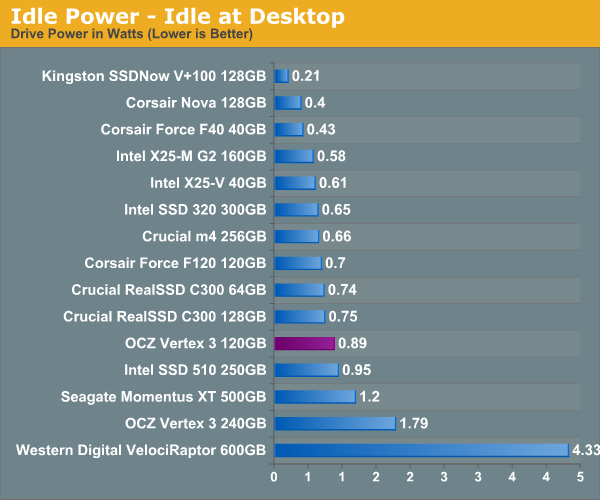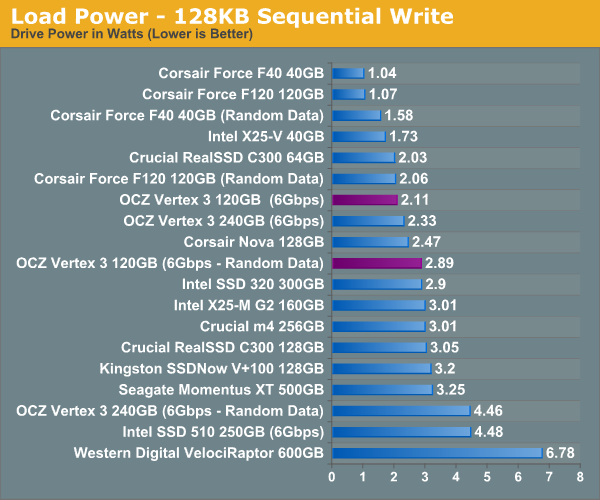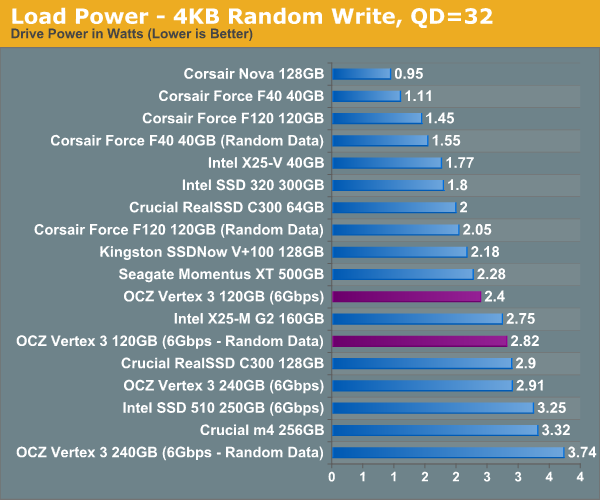The OCZ Vertex 3 Review (120GB)
by Anand Lal Shimpi on April 6, 2011 6:32 PM ESTTRIM Performance
In our Vertex 3 preview I mentioned a bug/performance condition/funnythingthathappens with SF-1200 based drives. If you write incompressible data to all LBAs on the drive (e.g. fill the drive up with H.264 videos) and fill the spare area with incompressible data (do it again without TRIMing the drive) you'll actually put your SF-1200 based SSD into a performance condition that it can't TRIM its way out of. Completely TRIM the drive and you'll notice that while compressible writes are nice and speedy, incompressible writes happen at a max of 70 - 80MB/s. In our Vertex 3 Pro preview I mentioned that it seemed as if SandForce had nearly fixed the issue. The worst I ever recorded performance on the 240GB drive after my aforementioned fill procedure was 198MB/s - a pretty healthy level.
The 120GB drive doesn't mask the drop nearly as well. The same process I described above drops performance to the 100 - 130MB/s range. This is better than what we saw with the Vertex 2, but still a valid concern if you plan on storing/manipulating a lot of highly compressed data (e.g. H.264 video) on your SSD.
The other major change since the preview? The 120GB drive can definitely get into a pretty fragmented state (again only if you pepper it with incompressible data). I filled the drive with incompressible data, ran a 4KB (100% LBA space, QD32) random write test with incompressible data for 20 minutes, and then ran AS-SSD (another incompressible data test) to see how low performance could get:
| OCZ Vertex 3 120GB - Resiliency - AS SSD Sequential Write Speed - 6Gbps | |||||
| Clean | After Torture | After TRIM | |||
| OCZ Vertex 3 120GB | 162.1 MB/s | 38.3 MB/s | 101.5 MB/s | ||
Note that the Vertex 3 does recover pretty well after you write to it sequentially. A second AS-SSD pass shot performance up to 132MB/s. As I mentioned above, after TRIMing the whole drive I saw performance in the 100 - 130MB/s range.
This is truly the worst case scenario for any SF based drive. Unless you deal in a lot of truly random data or plan on storing/manipulating a lot of highly compressed files (e.g. compressed JPEGs, H.264 videos, etc...), I wouldn't be too concerned about this worst-case scenario performance. What does bother me however is how much lower the 120GB drive's worst case is vs. the 240GB.
Power Consumption
Unusually high idle power consumption was a bug in the early Vertex 3 firmware - that seems to have been fixed with the latest firmware revision. Overall power consumption seems pretty good for the 120GB drive, it's in line with other current generation SSDs we've seen although we admittedly haven't tested many similar capacity drives this year yet.













153 Comments
View All Comments
Super - Friday, April 8, 2011 - link
...perhaps the Nobel Peace Prize. ?? i've seen someone win it for a whole lot less *cough ObamaA5 - Wednesday, April 6, 2011 - link
Agreed - glad they listen to Anand.The real question is why they didn't do anything until Anand bitched to the CEO directly. It's not like they weren't aware of the issue - the Storage Review article came out several months ago...
darckhart - Wednesday, April 6, 2011 - link
It just goes to show that companies are not customer focused. Unless they get shoved hard enough, or see that the bottom line will be affected greatly, they just hope you'll give up after being mired in the revolving email chain or sent through 5 level deep phone support.Thanks Anand for reminding companies that some of us are still capable of making informed decisions and aren't afraid to express our dissatisfaction with our dollars.
789427 - Thursday, April 7, 2011 - link
It's not about being customer focussed or not. Quite frankly, what percentage of upgraders will go into this level of detail?Furthermore, 25nm sounds better than 35nm to most people and that's salesmen included.
After all that, it's a victory for transparency for a tiny few.
In terms of marketing, there's little you can do except re-brand the entire product range.
e.g. Silver and Silver Pro for the lower capacities, Gold and Gold Pro for the higher capacities and explain on the box that fewer chips means generally lower performance
The problem here is that this is the cutting edge of technology and that in 12 months time, it will be surpassed. Then how do you re-vamp the line?
Graphics cards have this problem too and the model numbers are baffling for 99% of first-time buyers.
What I would advocate is a sticker valid for 3 months on the product that lets you know which product in terms of performance you are buying and a URL you can visit to check for an update.
e.g.
Your product: xyz 300-35
is better than xyz 300-24
but is worse than 300-ii
Check Real performance figures here: URL
Then it would be nice for salesmen to allow customers to verify this.
cb
cactusdog - Wednesday, April 6, 2011 - link
Yep, at least OCZ have made a commitment not to use slow hynix nand and are being more transparent with real world performance but its all too little too late.Branding drives with the 25 or 34nm prefix is redundant now that all(or most) nand being produced is 25nm. Ocz made no real attempt to fix the problem when they needed to, and continued to sell the drives even after the consumer backlash.
I disagree with Anand that other manufacturers of sandforce controller drives hide the specs as OCZ did. Corsair rebranded their 25nm drives from the start. Other non sandforce drives from Intel also rebranded their 25nm drives.
Its true that many companies use different components and use the same branding but rarely does the performance vary as much as 30%. 30% is a huge and not acceptable for high end expensive parts..
Its a pity Anand didnt really have anything to add on the Spectek issue that hasnt already been said. I find it hard to believe a company like Micron would sell very expensive nand cheaper to Spectek unless there is some problem with it.
Saying Spectek nand must be OK because it is still rated at 3000 cycles doesnt sound very thorough or tell us the whole story. The cycle rating could have very different testing standards between Micron and Spectek.
I would have thought it would be easy for someone like Anand to ask Micron or Spectek if the Spectek nand is tier 1 nand or not. I wouldnt trust OCZ response given their track record.
Overall though thanks Anand for sticking up for the consumers.
Powerlurker - Wednesday, April 6, 2011 - link
According to their corporate website "SpecTek began at Micron in 1988 as a component-recovery group." which would lead me to believe that they're Micron's low-end brand for disposing of lower performing dies.Xneb - Thursday, April 7, 2011 - link
That is correct. testing is the same though so end users should not be able to tell the difference between spectek and imft nand in these drives.sleepeeg3 - Thursday, April 7, 2011 - link
You can't fault him for reporting honestly. There is no concrete data that shows Spectek NAND is inferior to Micron.Alkapwn - Wednesday, April 6, 2011 - link
Ditto! Keep up the great work! We all appreciate it greatly!Mr Perfect - Thursday, April 7, 2011 - link
Yes, thank you for addressing the Vertex 2 issue.The sad part is that if OCZ had used their new, transparent labeling scheme from day one, they would have been praised for their transparency and all of the other companies would have been expected to rise to their standard. Instead, they waited through months of consumer and press outcry, meaning this fair and honest SKU system is merely re-earning lost trust.